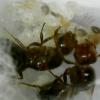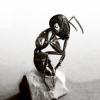Does anyone have a technique of using tweezers to pick up ants or brood effectively without squishing them? The last few times I used them to pick up pupae, I was so scared of smashing them I kept dropping them instead. How to you gauge the right amount of pressure to apply?
- Formiculture.com
- Forums
- Gallery
- Members
- Member Map
- Chat



















